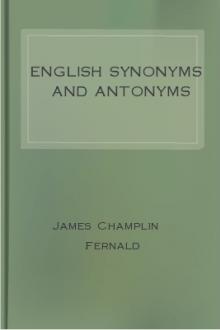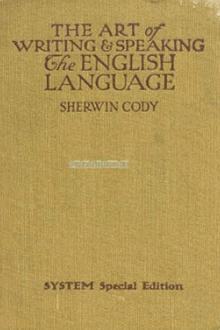Complete Hypnotism, Mesmerism, Mind-Reading and Spritualism, A. Alpheus [spiritual books to read .txt] 📗

- Author: A. Alpheus
- Performer: -
Book online «Complete Hypnotism, Mesmerism, Mind-Reading and Spritualism, A. Alpheus [spiritual books to read .txt] 📗». Author A. Alpheus
Bad Habits.--The habit of the excessive use of alcoholic drinks, morphine, tobacco, or the like, may often be decidedly helped by hypnotism, if the patient wants to be helped. The method of operation is simple. The operator hypnotizes the subject, and when he is in deep sleep suggests that on awaking he will feel a deep disgust for the article he is in the habit of taking, and if he takes it will be affected by nausea, or other unpleasant symptoms. In most cases the suggested result takes place, provided the subject can be hypnotized al all; but unless the patient is himself anxious to break the habit fixed upon him, the unpleasant effects soon wear off and he is as bad as ever.
Dr. Cocke treated a large number of cases, which he reports in detail in his book on hypnotism. In a fair proportion of the cases he was successful; in some cases completely so. In other cases he failed entirely, owing to lack of moral stamina in the patient himself. His conclusions seem to be that hypnotism may be made a very effective aid to moral suasion, but after all, character is the chief force which throws off such habits once they are fixed. The morphine habit is usually the result of a doctor's prescription at some time, and it is practiced more or less involuntarily. Such cases are often materially helped by the proper suggestions.
The same is true of bad habits in children. The weak may be strengthened by the stronger nature, and hypnotism may come in as an effective aid to moral influence. Here again character is the deciding factor.
Dr. James R. Cocke devotes a considerable part of his book on "Hypnotism" to the use of hypnotism in medical practice, and for further interesting details the reader is referred to that able work.
CHAPTER X.
Hypnotism of Animals.--Snake Charming.
We are all familiar with the snake charmer, and the charming of birds by snakes. How much hypnotism there is in these performances it would be hard to say. It is probable that a bird is fascinated to some extent by the steady gaze of a serpent's eyes, but fear will certainly paralyze a bird as effectively as hypnotism.
Father Kircher was the first to try a familiar experiment with hens and cocks. If you hold a hen's head with the beak upon a piece of board, and then draw a chalk line from the beak to the edge of the board, the hen when released will continue to hold her head in the same position for some time, finally walking slowly away, as if roused from a stupor. Farmers' wives often try a sort of hypnotic experiment on hens they wish to transfer from one nest to another when sitting. They put the hen's head under her wing and gently rock her to and fro till she apparently goes to sleep, when she may be carried to another nest and will remain there afterward.
Horses are frequently managed by a steady gaze into their eyes. Dr. Moll states that a method of hypnotizing horses named after its inventor as Balassiren has been introduced into Austria by law for the shoeing of horses in the army.
We have all heard of the snake charmers of India, who make the snakes imitate all their movements. Some suppose this is by hypnotization. It may be the result of training, however. Certainly real charmers of wild beasts usually end by being bitten or injured in some other way, which would seem to show that the hypnotization does not always work, or else it does not exist at all.
We have some fairly well known instances of hypnotism produced in animals. Lafontaine, the magnetizer, some thirty years ago held public exhibitions in Paris in which he reduced cats, dogs, squirrels and lions to such complete insensibility that they felt neither pricks nor blows.
The Harvys or Psylles of Egypt impart to the ringed snake the appearance of a stick by pressure on the head, which induces a species of tetanus, says E. W. Lane.
The following description of serpent charming by the Aissouans of the province of Sous, Morocco, will be of interest:
"The principal charmer began by whirling with astonishing rapidity in a kind of frenzied dance around the wicker basket that contained the serpents, which were covered by a goatskin. Suddenly he stopped, plunged his naked arm into the basket, and drew out a cobra de capello, or else a haje, a fearful reptile which is able to swell its head by spreading out the scales which cover it, and which is thought to be Cleopatra's asp, the serpent of Egypt. In Morocco it is known as the buska. The charmer folded and unfolded the greenish-black viper, as if it were a piece of muslin; he rolled it like a turban round his head, and continued his dance while the serpent maintained its position, and seemed to follow every movement and wish of the dancer.
"The buska was then placed on the ground, and raising itself straight on end, in the attitude it assumes on desert roads to attract travelers, began to sway from right to left, following the rhythm of the music. The Aissoua, whirling more and more rapidly in constantly narrowing circles, plunged his hand once more into the basket, and pulled out two of the most venomous reptiles of the desert of Sous; serpents thicker than a man's arm, two or three feet long, whose shining scales are spotted black or yellow, and whose bite sends, as it were, a burning fire through the veins. This reptile is probably the torrida dipsas of antiquity. Europeans now call it the leffah.
"The two leffahs, more vigorous and less docile than the buska, lay half curled up, their heads on one side, ready to dart forward, and followed with glittering eyes the movements of the dancer. * * * Hindoo charmers are still more wonderful; they juggle with a dozen different species of reptiles at the same time, making them come and go, leap, dance, and lie down at the sound of the charmer's whistle, like the gentlest of tame animals. These serpents have never been known to bite their charmers."
It is well known that some animals, like the opossum, feign death when caught. Whether this is to be compared to hypnotism is doubtful. Other animals, called hibernating, sleep for months with no other food than their fat, but this, again, can hardly be called hypnotism.
CHAPTER XI.
A Scientific Explanation of Hypnotism.--Dr. Hart's Theory.
In the introduction to this book the reader will find a summary of the theories of hypnotism. There is no doubt that hypnotism is a complex state which cannot be explained in an offhand way in a sentence or two. There are, however, certain aspects of hypnotism which we may suppose sufficiently explained by certain scientific writers on the subject.
First, what is the character of the delusions apparently created in the mind of a person in the hypnotic condition by a simple word of mouth statement, as when a physician says, "Now, I am going to cut your leg off, but it will not hurt you in the least," and the patient suffers nothing?
In answer to this question, Professor William James of Harvard College, one of the leading authorities on the scientific aspects of psychical phenomena in this country, reports the following experiments:
"Make a stroke on a paper or blackboard, and tell the subject it is not there, and he will see nothing but the clean paper or board. Next, he not looking, surround the original stroke with other strokes exactly like it, and ask him what he sees. He will point out one by one the new strokes and omit the original one every time, no matter how numerous the next strokes may be, or in what order they are arranged. Similarly, if the original single line, to which he is blind, be doubled by a prism of sixteen degrees placed before one of his eyes (both being kept open), he will say that he now sees one stroke, and point in the direction in which lies the image seen through the prism.
"Another experiment proves that he must see it in order to ignore it. Make a red cross, invisible to the hypnotic subject, on a sheet of white paper, and yet cause him to look fixedly at a dot on the paper on or near the red cross; he wills on transferring his eye to the blank sheet, see a bluish-green after image of the cross. This proves that it has impressed his sensibility. He has felt but not perceived it. He had actually ignored it; refused to recognize it, as it were."
Dr. Ernest Hart, an English writer, in an article in the British Medical Journal, gives a general explanation of the phenomena of hypnotism which we may accept as true so far as it goes, but which is evidently incomplete. He seems to minimize personal influence too much--that personal influence which we all exert at various times, and which he ignores, not because he would deny it, but because he fears lending countenance to the magnetic fluid and other similar theories. Says he:
"We have arrived at the point at which it will be plain that the condition produced in these cases, and known under a varied jargon invented either to conceal ignorance, to express hypotheses, or to mask the design of impressing the imagination and possibly prey upon the pockets of a credulous and wonder-loving public--such names as mesmeric condition, magnetic sleep, clairvoyance, electro-biology, animal magnetism, faith trance, and many other aliases--such a condition, I say, is always subjective. It is independent of passes or gestures; it has no relation to any fluid emanating from the operator; it has no relation to his will, or to any influence which he exercises upon inanimate objects; distance does not affect it, nor proximity, nor the intervention of any conductors or non-conductors, whether silk or glass or stone, or even a brick wall. We can transmit the order to sleep by telephone or by telegraph. We can practically get the same results while eliminating even the operator, if we can contrive to influence the imagination or to affect the physical condition of the subject by any one of a great number of contrivances.
"What does all this mean? I will refer to one or two facts in relation to the structure and function of the brain, and show one or two simple experiments of very ancient parentage and date, which will, I think, help to an explanation. First, let us recall something of what we know of the anatomy and localization of function in the brain, and of the nature of ordinary sleep. The brain, as you know, is a complicated organ, made up internally of nerve masses, or ganglia, of which the central and underlying masses are connected with the automatic functions and involuntary actions of the body (such as the action of the heart, lungs, stomach, bowels, etc.), while the investing surface shows a system of complicated convolutions rich in gray matter, thickly sown with microscopic cells, in which the nerve ends terminate. At the base of the brain is a complete circle





Comments (0)